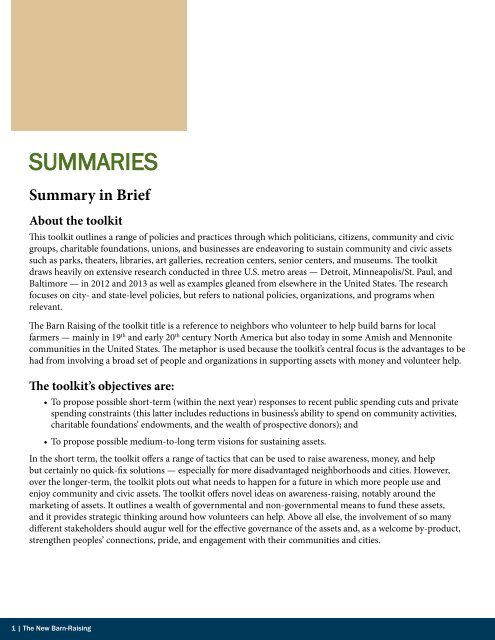bQNs7mR
bQNs7mR
bQNs7mR
You also want an ePaper? Increase the reach of your titles
YUMPU automatically turns print PDFs into web optimized ePapers that Google loves.
SUMMARIES<br />
Summary in Brief<br />
About the toolkit<br />
This toolkit outlines a range of policies and practices through which politicians, citizens, community and civic<br />
groups, charitable foundations, unions, and businesses are endeavoring to sustain community and civic assets<br />
such as parks, theaters, libraries, art galleries, recreation centers, senior centers, and museums. The toolkit<br />
draws heavily on extensive research conducted in three U.S. metro areas — Detroit, Minneapolis/St. Paul, and<br />
Baltimore — in 2012 and 2013 as well as examples gleaned from elsewhere in the United States. The research<br />
focuses on city- and state-level policies, but refers to national policies, organizations, and programs when<br />
relevant.<br />
The Barn Raising of the toolkit title is a reference to neighbors who volunteer to help build barns for local<br />
farmers — mainly in 19 th and early 20 th century North America but also today in some Amish and Mennonite<br />
communities in the United States. The metaphor is used because the toolkit’s central focus is the advantages to be<br />
had from involving a broad set of people and organizations in supporting assets with money and volunteer help.<br />
The toolkit’s objectives are:<br />
• To propose possible short-term (within the next year) responses to recent public spending cuts and private<br />
spending constraints (this latter includes reductions in business’s ability to spend on community activities,<br />
charitable foundations’ endowments, and the wealth of prospective donors); and<br />
• To propose possible medium-to-long term visions for sustaining assets.<br />
In the short term, the toolkit offers a range of tactics that can be used to raise awareness, money, and help<br />
but certainly no quick-fix solutions — especially for more disadvantaged neighborhoods and cities. However,<br />
over the longer-term, the toolkit plots out what needs to happen for a future in which more people use and<br />
enjoy community and civic assets. The toolkit offers novel ideas on awareness-raising, notably around the<br />
marketing of assets. It outlines a wealth of governmental and non-governmental means to fund these assets,<br />
and it provides strategic thinking around how volunteers can help. Above all else, the involvement of so many<br />
different stakeholders should augur well for the effective governance of the assets and, as a welcome by-product,<br />
strengthen peoples’ connections, pride, and engagement with their communities and cities.<br />
1 | The New Barn-Raising


